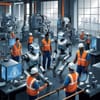Artificial intelligence is transforming blue-collar jobs across manufacturing and logistics, bringing about both efficiency and safety benefits, as well as concerns about job displacement and social inequality. The impact of AI on blue-collar labor is multifaceted, with automation reducing demand for manual labor in sectors like assembly line work and logistics.
However, AI adoption is also creating new job opportunities in areas like AI hardware maintenance, system operation, and data management. Companies like Tesla and Amazon are integrating AI to handle inventory and delivery, increasing productivity and efficiency. AI-powered machines can predict maintenance needs, minimizing downtime and enhancing safety protocols in hazardous environments.
While AI may displace entry-level positions, pushing workers into precarious gig economies and exacerbating inequality, workers trained on AI interfaces report higher job satisfaction. AI collaboration can redefine blue-collar careers from routine tasks to strategic roles, where human skills complement AI-driven tools.
To prepare for the future, governments and industry bodies are implementing initiatives to support workers, including funding vocational education and training programs. Workers will need to develop skills to operate and maintain advanced machinery, and adapt to technology-driven processes. The future of blue-collar jobs lies in a hybrid approach, where human skills complement AI-driven tools, and workers are equipped to thrive in an AI-driven economy.


